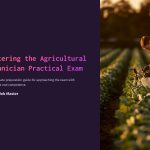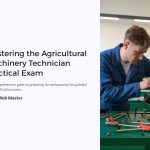 Preparing for the Agricultural Technician Practical Exam requires a strategic approach to ensure success. This guide provides comprehensive insights into the exam structure, essential preparation materials, and effective study techniques to help you excel.
Preparing for the Agricultural Technician Practical Exam requires a strategic approach to ensure success. This guide provides comprehensive insights into the exam structure, essential preparation materials, and effective study techniques to help you excel.

Understanding the Exam Structure
The Agricultural Technician Practical Exam evaluates candidates on their ability to perform specific agricultural tasks and apply theoretical knowledge in practical scenarios. The exam typically consists of:
- Practical Tasks: Hands-on activities that assess technical skills in areas such as crop cultivation, soil management, and equipment operation.
- Written Components: Some versions may include written assessments to test understanding of agricultural principles and practices.
Familiarizing yourself with the exam format is crucial for effective preparation.
Essential Preparation Materials
To adequately prepare for the practical exam, gather the following materials:
- Approved Identification: A valid ID is mandatory for exam entry. Accepted forms include a resident registration card, driver’s license, valid passport, public official ID, welfare card, or major licenses and certificates. Ensure your ID is current and recognized by the examination authority. citeturn0search0
- Writing Instruments: Use only black ink pens for written components. Avoid erasable pens, pencils, or pens of other colors, as responses written with these may not be graded. citeturn0search0
- Permitted Calculators: If the exam allows calculator use, ensure it is from the approved list provided by the examination authority. Unauthorized models are prohibited. citeturn0search0
- Other Tools: Depending on the specific tasks, you may need additional tools or equipment. Refer to the official exam guidelines for a detailed list.


Effective Study Techniques
Enhance your preparation with these strategies:
- Hands-On Practice: Engage in practical agricultural activities to build muscle memory and confidence. This includes tasks like planting, soil testing, and machinery operation.
- Theoretical Review: Study agricultural science principles, focusing on areas such as crop physiology, pest management, and sustainable farming practices.
- Mock Exams: Simulate exam conditions by timing yourself during practice tasks to improve time management skills.
- Study Groups: Collaborate with peers to share knowledge, discuss complex topics, and provide mutual support.
Time Management During the Exam
Efficient time allocation is vital:
- Task Prioritization: Quickly assess all tasks and begin with those you are most confident in to secure marks early.
- Time Allocation: Assign specific time slots to each task and adhere to them to ensure all tasks are addressed.
- Buffer Time: Reserve a few minutes at the end to review your work and make necessary corrections.


Health and Well-being Tips
Maintain optimal performance by:
- Adequate Rest: Ensure you get sufficient sleep before the exam day to enhance concentration and cognitive function.
- Nutrition: Consume a balanced meal prior to the exam to maintain energy levels.
- Stress Management: Practice relaxation techniques such as deep breathing or meditation to alleviate anxiety.

Post-Exam Considerations
After completing the exam:
- Reflect on Performance: Analyze the tasks to identify areas of strength and those needing improvement.
- SeAgricultural Technician Practical Exam Preparationek Feedback: If possible, obtain feedback from examiners to understand evaluation criteria and performance nuances.
- Continuous Learning: Stay updated with advancements in agricultural techniques and technologies to enhance future performance.
By adhering to this guide, you can approach the Agricultural Technician Practical Exam with confidence and competence, paving the way for a successful career in agriculture.
*Capturing unauthorized images is prohibited*


